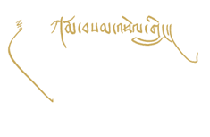Buddhism
What is Buddhism, in fact (and what not)?
Buddhism is a religion based on realisation, not on faith. It has neither a holy scripture, which is authoritative for all its tradition, nor a common head or leader.
The Buddha was a human being who, as documented by historical evidence, lived approximately 2600 years ago in Northern India. Those who follow his teachings venerate him not as a god, but as a paragon and guide, whom they try to emulate.
Siddhartha Gautama, the later Buddha, grew up as the son of a local ruler in privileged circumstances. Through encounters with an old man, a sick person, and a corpse, he realised that there are things in life, which the "rich and beautiful" too cannot escape. In consequence, surging doubts led him to leave his family at the age of 29 und to start on a path of spiritual quest. He learned the basics of meditation and later practiced asceticism in solitude for six years. However, he quickly realised that this spiritual way, like the opulence he had experienced during his youth, does not lead to the goal of spiritual attainment either; only a middle way between those two extremes can be a proper means to achieve this aim. Based on this realisation, he continued his practice alone and finally attained Buddhahood, the Enlightened State ? perfect insight into the true nature of mind as well as of all phenomena.
After that, the Buddha wandered through Northern India for 45 years and acted as a spiritual guide for those who showed interest in his teachings. He founded a monastic order of monks and later of nuns too, whose members could concentrate fully on their spiritual practice while being sustained by donations from the lay community. Finally, at the age of 80, the Buddha died and entered Parinirvana.
In the following centuries, the so-called "Three Vehicles of Buddhism" developed, due to differing viewpoints of the teachings and their interpretation: the so-called Theravada (today prevalent mostly in SE-Asia) lays its emphasis on attaining one's own liberation, but without disregarding loving kindness and compassion towards other beings. The Great Vehicle (Mahayana; predominantly in China, Korea and Japan) is based on the ideal of the bodhisattva who aspires to attain Enlightenment primarily for the benefit of all sentient beings. The Diamond Vehicle (Vajrayana, Mantrayana, or Tantric Buddhism; prevalent in Tibet and other Himalayan countries as well as Mongolia) encompasses the other two vehicles and, in addition, includes special meditation methods, which enable a more rapid spiritual progress.
What is Tibetan Buddhism?
Strictly speaking, this is a confusing term because it did not arise independently in Tibet, but is entirely based on Buddhism as it developed in India up to approximately 1000 A.D. In the 7th century, the Buddha's doctrine started to reach Tibet, where it evolved further in a characteristic way through contact with the indigenous shamanistic Bön religion. In this way, the four main lineages of Tibetan Buddhism still existing today (Nyingma, Sakya, Kagyü and Gelug) with their subdivisions came into being, originating from transmission lineages from teachers to their disciples. These traditions show manifold connections and relations between each other and differ rather in the emphasis placed upon the texts and rituals used for practice than in their interpretation of fundamental points of the Buddha's doctrine.
What is the Karma Kagyü tradition?
The great Indian master Tilopa (988-1069) combined different traditions originating with Buddha Shakyamuni and transmitted them to his main disciple Naropa. Via Naropa's pupil Marpa, the Kagyü transmission then reached Tibet in the 11th century. There it continued to be developed through the work of enlightened masters like the yogi and poet Milarepa, or Gampopa who founded the first monastery of the Kagyü lineage, and the incarnation lineage of the Karmapas, the first consciously reborn lamas in Tibet. The Karma Kagyü tradition is one of 12 sub-divisions of the Kagyü transmission lineage. Through the efforts of the 16th Karmapa, Rangjung Rigpe Dorje (1924-1981), who had to escape into exile from the Chinese invasion in 1959, these teachings have spread to the Western hemisphere as well.







